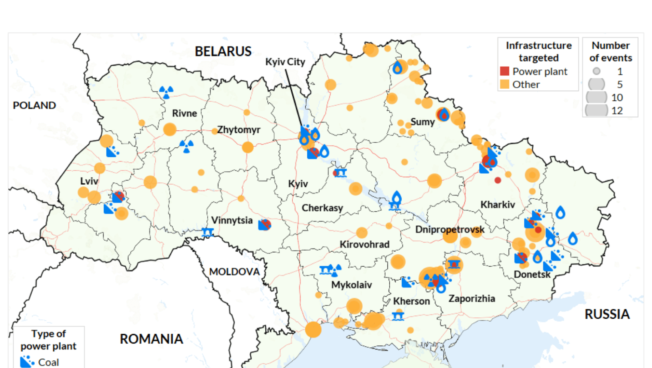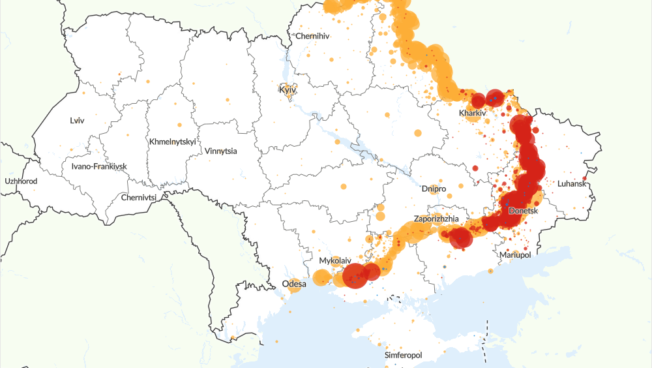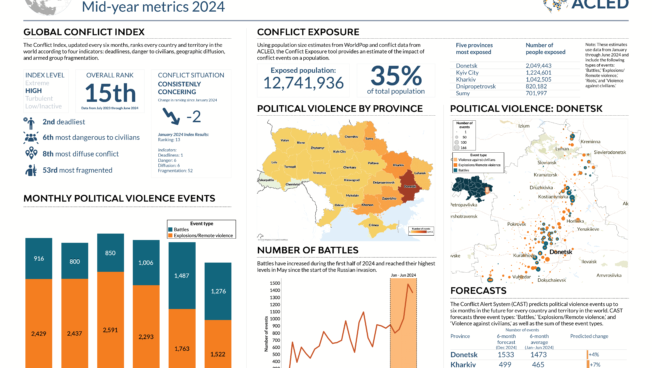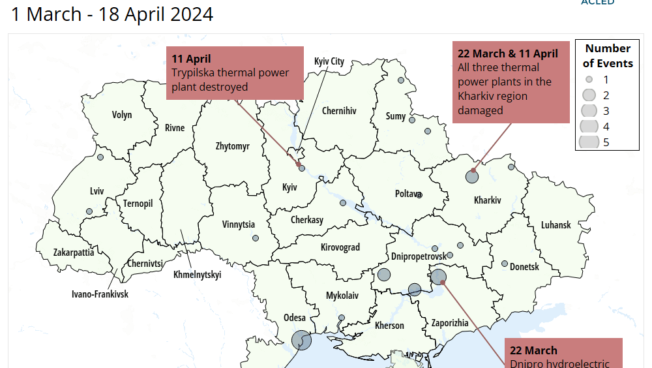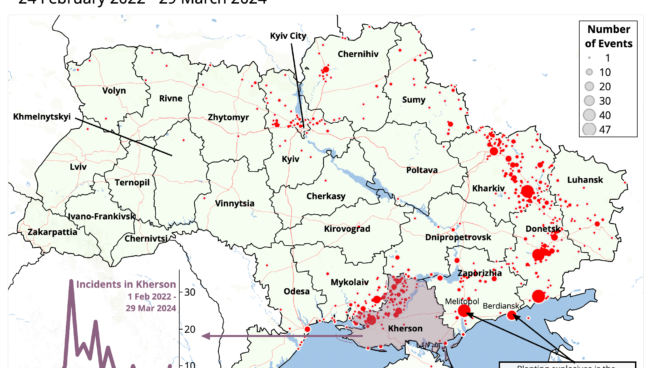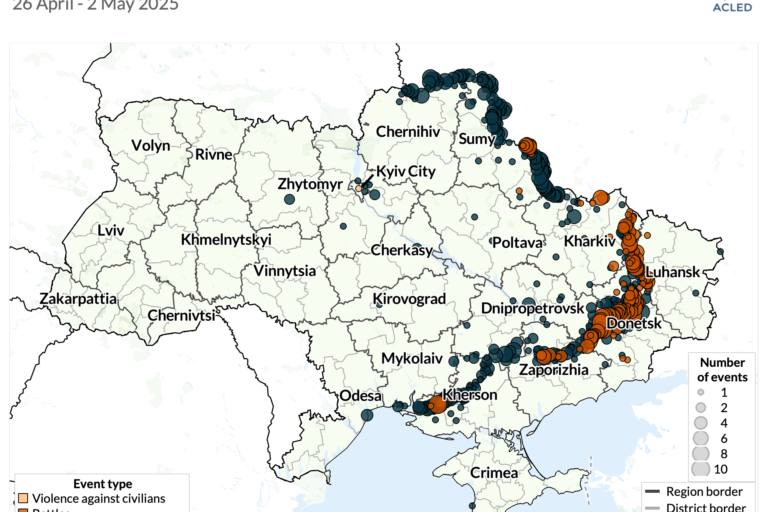Last updated: 14 May 2025
Amid the ongoing war in Ukraine, this aerial photograph shows the destruction in the village of Bohorodychne in the Donetsk region on 27 January 2024. Photo by Roman Pilipey/AFP via Getty Images
ACLED’s Ukraine Conflict Monitor provides near real-time information on the ongoing war, including an interactive map of the latest data from the start of Russia’s invasion, a curated data file, and weekly situation updates. It is designed to help researchers, policymakers, media, and the wider public track key conflict developments in Ukraine. It is released every Wednesday, with data covering events from Saturday to Friday of the preceding week and providing updates to past events as new or better information becomes available.
Ukraine war situation update
3 – 9 May 2025
Key trends
- In the Donetsk region, Russian forces advanced south and southwest of Kostiantynivka, southwest of Pokrovsk, and north and northeast of Lyman, in addition to occupying a village west of Velyka Novosilka.
- Russian forces made gains in the area of Kupiansk in the Kharkiv region and claimed to have advanced near the international border northeast of Sumy city.
- ACLED records at least 30 Russian long-range missile and drone strikes, including in Kyiv city and the Kyiv region, as well as the central regions of Cherkasy, Poltava, and Kirovohrad.
- Russian shelling, missiles, aerial bombs, and drones killed at least 32 civilians in the Dnipropetrovsk, Donetsk, Kharkiv, Kherson, Odesa, Sumy, and Zaporizhia regions and in Kyiv city. Ukrainian shelling reportedly killed one civilian in the Russian-occupied part of the Kherson region.
Key events
- 3 May | Donetsk – Russian forces execute three Ukrainian prisoners of war near Novopil
- 6 May | Sumy – Russian missiles strike Velyka Chernechchyna near Sumy city, killing three civilians
- 7 May | Kyiv city – Russian drones and missiles kill two civilians and wound eight others
Spotlight: Moscow faces Ukrainian drones and ceasefire counter-proposals
Ukrainian drone barrages disrupted air traffic in and around Moscow ahead of 9 May commemorations of the 80th anniversary of Soviet and Allies’ victory in World War II, which included a military parade on the Red Square. Hundreds of Ukrainian drones attempted to break through Russia’s air defences in the European part of the country between 6 and 8 May, with Moscow appearing to be the primary target. Russian forces largely fended off strike attempts, claiming to have intercepted over 500 drones in the 24 hours between 6 and 7 May alone.1Reuters, “Russian air defences down 12 more Ukrainian drones en route to Moscow, mayor says,” 7 May 2025 ACLED data show drone intercepts over at least 20 regions on 6 and 7 May, compared with a weekly average of 13 regions since the beginning of the year.
Five strike attempts were reported over Moscow and the surrounding eponymous region, including a direct hit on a military airfield and another event in which a residential building was damaged by falling debris. Additionally, a Russian air defense missile involved in an interception damaged a residential building in a Moscow suburb. The strike attempts led to the closures of airports across Russia, including all around Moscow, delaying the arrival of foreign leaders attending the 9 May parade.2Jessica Rawnsley and Jaroslav Lukiv, “Russia says 60,000 air passengers stranded after Ukrainian drone attacks,” BBC, 7 May 2025 To complicate the navigation of drones ahead of and on 9 May, Russian authorities resorted to the near-complete shutdown of cellular networks in Moscow and elsewhere in the country.3Meduza, “Ahead of Moscow’s Victory Day parade, Internet is cut, shops close, and services stall as authorities scramble to prevent drone attacks,” 9 May 2025
Earlier, Russia’s President Vladimir Putin announced a second unilateral ceasefire between 8 and 11 May, likely aiming to force Ukraine to mirror the move to improve the odds of the parade passing without incident. Unlike in the case of the Easter ceasefire, Ukraine refused to reciprocate and demanded a month-long truce.4Hanna Arhirova and Elise Morton, “Russia and Ukraine clash over ceasefire proposals as fighting rages,” The Associated Press, 3 May 2025 In response, Putin proposed unconditional talks on 15 May in Turkey. Ukraine’s President Volodymyr Zelenskyy agreed and challenged Putin to a personal meeting.5Max Hunder and Yuliia Dysa, “Ukraine’s Zelenskiy insists on face-to-face talks with Putin in Istanbul,” Reuters, 13 May 2025
Explore the ACLED Conflict Exposure tool to assess the numbers of people affected by armed violence, disaggregated by locations, time period, and actors involved.
Ukraine Conflict: Interactive Map
This interactive map includes political violence events in Ukraine since the start of the Russian invasion on 24 February 2022.
Date and subset filters
By default, the map displays data for the most recent week. Use the date filters to change the date range in view.
Use the subset filters to analyze trends in more detail.
Changing view
By default, the map is set to event view, which uses scaled circles to show events at a given location. Click on a region in Ukraine to zoom in for a more detailed view. Hovering over a region will give a count of events within its borders.
Changing to region (oblast) view will switch the map to a choropleth, giving an overview of event density per region. This will also disable the zoom function.
Events in Russia
While in event view, use the ‘Events in Russia’ toggle to show or hide conflict-related events in Russia. Conflict-related events are identified as follows:
- All events with the ‘Battles’ or ‘Explosions/remote violence’ event type.
- Events with the ‘Violence against civilians’ event type, where the actor is:
- Ukrainian or Russian military
- Russian border guards
- Pro-Ukrainian Russian militias
Attacks on Ukranian infrastructure
ACLED uses four automatically generated infrastructure tags when coding events that occur in Ukraine, each covering a vital sector that focuses on civilian infrastructure: energy, health, education, and residential infrastructure.
For more information, read our methodology explainer.
Event counts and civilian fatalities
The box in the bottom right hand corner displays event counts in total, disaggregated by event type, and filtered by date or subset according to the options already selected.
It also shows a conservative estimate of civilian fatalities, limited to events where civilians are targeted directly. Military casualties are not represented on the map as they are largely unverifiable.
For more information on how ACLED codes fatalities, read our methodology explainer.
Curated Data
This file contains all political violence events, demonstration events, and strategic developments recorded in Ukraine and the Black Sea from the beginning of ACLED coverage in 2018 to the present.
For an overview, see our interactive dashboard.
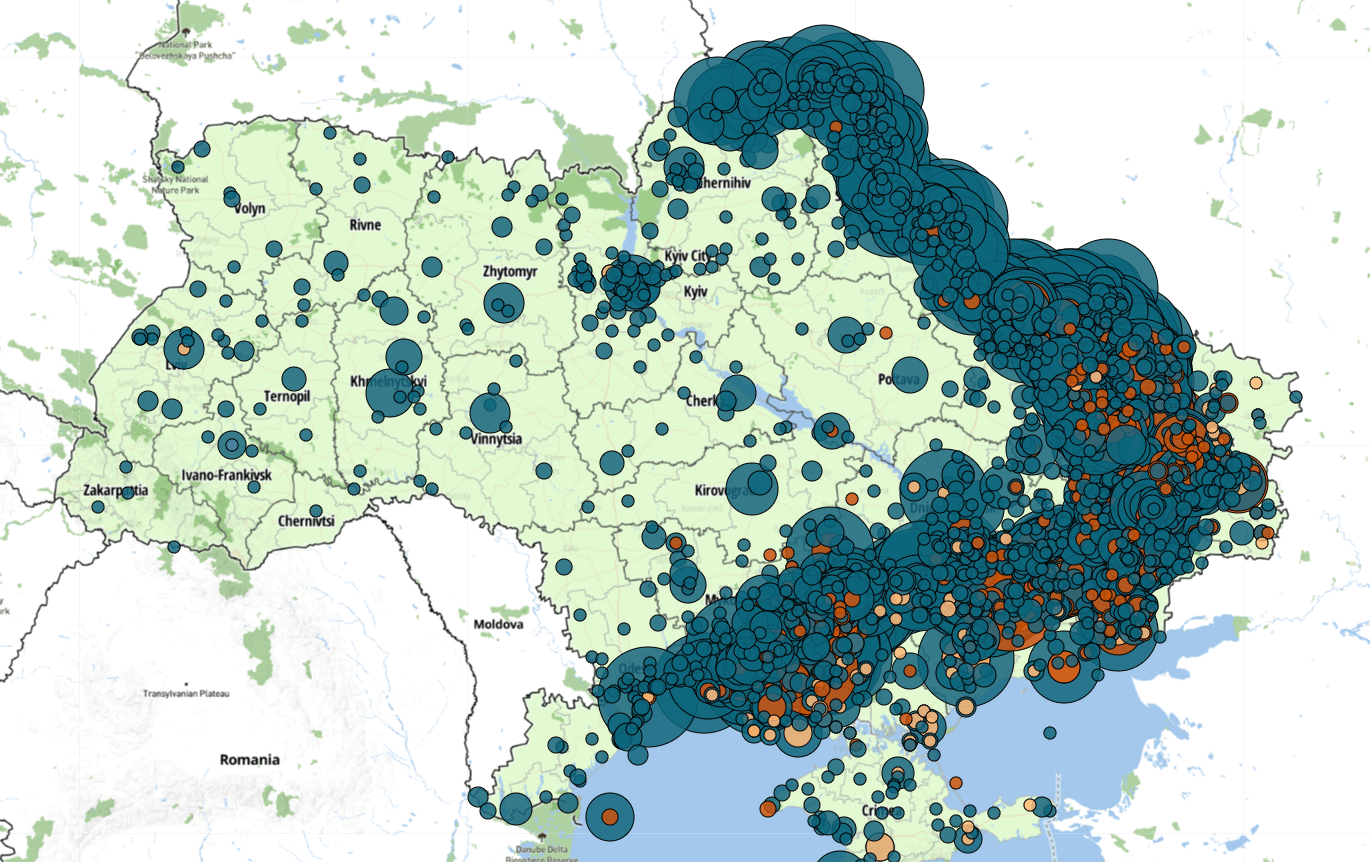
Ukraine & the Black Sea ( 09 May 2025 )
Attacks on Ukranian infrastructure
ACLED uses four automatically generated infrastructure tags when coding events that occur in Ukraine, each covering a vital sector that focuses on civilian infrastructure: energy, health, education, and residential infrastructure. This file contains all events featuring one or more of these tags.
For more information, read our methodology note.
Sign up for Ukraine Conflict Monitor updates
Information & Analysis
For additional information on the conflict in Ukraine, check our analysis of political violence trends from the start of ACLED coverage in 2018.

